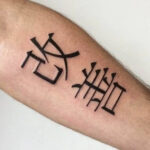Second skin, often recognized by brands like Saniderm, has become a popular choice for tattoo aftercare among artists and clients alike. This innovative adhesive bandage offers a superior healing environment compared to traditional methods, but understanding its proper use is crucial. As a content creator at tattooat.com and a tattoo enthusiast, I’m here to provide an in-depth guide on second skin, focusing particularly on the optimal duration for keeping it on your new tattoo.
To truly appreciate the benefits of second skin and the importance of correct application and removal timing, it’s helpful to understand the science behind it. For those less interested in the scientific explanation, feel free to skip ahead to the practical guidelines.
Your fresh tattoo is essentially a controlled skin injury. The tattooing process involves needles penetrating the skin to deposit ink into the dermis layer. This creates an open wound, making it vulnerable to bacteria and infection during the initial healing phase. Second skin acts as a protective barrier, mimicking a scab but with enhanced benefits. Unlike a natural scab that forms in open air, second skin creates a moist healing environment. This is not just a matter of comfort; it’s scientifically proven to accelerate healing and improve tattoo quality.
Why is moist wound healing superior? When your body heals a wound naturally by forming a scab, it’s a process that requires significant energy. Moreover, the scab itself becomes a barrier that the body then needs to break down and remove. Second skin minimizes this effort. By maintaining a moist environment, it allows your body to direct its energy towards actual tissue repair rather than protection and scab management.
Keratinocytes, specialized skin cells vital for wound healing, thrive in moist conditions. In traditional dry healing, these cells must migrate under the scab to find moisture before they can effectively repair the wound. Under second skin, these cells can move freely across the wound surface, alongside beneficial enzymes, significantly speeding up the healing process. Furthermore, moist wound healing is known to boost collagen production, the fundamental protein for new tissue formation. This leads to faster and more efficient tissue regeneration in your tattooed area. An added advantage is pain reduction. A moist environment soothes nerve endings, reducing pain signals and consequently minimizing your body’s stress response, which can further reduce inflammation and fatigue, all contributing to a smoother healing journey for your new tattoo.
Alt text: Tattoo artist applying a large, transparent second skin bandage to a client’s newly inked arm, ensuring full coverage and smooth adhesion.
How Long Should You Keep Second Skin On?
Now, let’s get to the core question: how long to keep second skin on your tattoo? There isn’t a single, universal answer, as the ideal duration can vary based on several factors. However, general guidelines exist to ensure optimal healing and minimize potential complications.
Initial Application (First 24 Hours):
The first layer of second skin is typically applied by your tattoo artist immediately after completing your tattoo session. This initial bandage is crucial as it protects the fresh tattoo from immediate environmental bacteria and begins the moist wound healing process right away. It is generally recommended to keep this first layer of second skin on for approximately 24 hours.
Why 24 hours for the first layer? During the first day, your tattoo will weep plasma, ink, and blood. This is a normal part of the healing process. Second skin is breathable but waterproof, allowing excess fluids to accumulate underneath. After 24 hours, this fluid buildup can become significant and may compromise the bandage’s adhesion or create an overly moist environment, potentially increasing the risk of maceration (skin softening from excessive moisture).
Second Application (Days 2-4 or longer, if needed):
After removing the first layer, you will need to gently wash your tattoo with mild, fragrance-free soap and water, and pat it dry with a clean paper towel. You can then apply a second layer of second skin. This second application can typically stay on for a longer period, ranging from 3 to 7 days, or sometimes even longer, depending on your individual healing and the tattoo’s characteristics.
Factors Influencing Duration:
- Tattoo Size and Style: Larger tattoos or those with heavy shading or color packing might weep more and require slightly shorter intervals between changes, or potentially benefit from a longer overall second skin period. Smaller, linework-based tattoos might heal effectively with a shorter duration.
- Individual Healing Rate: Everyone heals differently. Some individuals naturally heal faster than others. Observe your tattoo and the bandage. Excessive fluid buildup, redness around the bandage edges, or signs of irritation might indicate the need for earlier removal.
- Bandage Condition: Monitor the integrity of the second skin. If the bandage starts to lift, peel at the edges, or gets compromised in any way, it’s best to remove and replace it, or switch to traditional aftercare if you’re nearing the end of the recommended duration.
- Artist’s Recommendations: Always prioritize the aftercare instructions provided by your tattoo artist. They are familiar with their techniques and the typical healing process associated with them. Their advice should be tailored to your specific tattoo and skin.
Alt text: Close-up of a forearm tattoo covered with transparent second skin, showcasing the clear, smooth surface of the bandage and the visible tattoo underneath.
Step-by-Step Guide to Second Skin Application and Removal:
Application (Typically done by your Tattoo Artist for the first layer):
- Clean and Dry Skin: Ensure the skin around the tattoo is clean, dry, and shaved if necessary.
- Apply the Bandage: The second skin should extend at least an inch beyond the edges of the tattoo in all directions to ensure a secure seal.
- Smooth and Secure: Gently smooth out any air bubbles and wrinkles, ensuring the bandage adheres well to the skin.
Removal:
- Soften the Adhesive: The easiest and least painful way to remove second skin is in the shower. Warm water helps to loosen the adhesive. You can also use a bit of mild, fragrance-free soap and water to help break down the adhesive.
- Peel Carefully: Starting at an edge, gently peel the second skin back, pulling it slowly and close to the skin in the direction of hair growth (if applicable). Avoid pulling upwards and away from the skin, as this can be painful and cause skin irritation.
- Wash and Dry: Once removed, wash the tattooed area gently with mild soap and water, and pat it dry with a clean paper towel.
What to Expect After Removing Second Skin
After removing second skin, your tattoo might appear slightly different than when it was freshly done. It’s common to see:
- Ink Pooling: Some ink may pool under the second skin, making the tattoo look blurry. This is normal and the excess ink will be washed away when you remove the bandage.
- Moisturized Skin: The skin under the second skin will be well-hydrated and may appear slightly wrinkled or feel sticky. This is due to the moist environment and is temporary.
- Reduced Scabbing (or No Scabbing): One of the significant benefits of second skin is minimized scabbing. You might see very minimal flaking, or none at all, compared to traditional dry healing.
Continue with your aftercare routine as advised by your artist, which usually involves keeping the tattoo clean and moisturized with a fragrance-free lotion.
Potential Issues and When to Seek Professional Advice
Second skin is generally safe and beneficial, but potential issues can arise:
- Allergic Reactions: Some individuals may be allergic to the adhesive in second skin. Signs of an allergic reaction include excessive redness, itching, rash, or small blisters around the bandage edges. If you suspect an allergic reaction, remove the second skin immediately and switch to traditional aftercare. Consult your tattoo artist or a healthcare professional if symptoms are severe.
- Infection: While second skin protects against infection, it’s still possible if the application wasn’t sterile or if the bandage is left on for too long and the environment becomes overly moist and anaerobic. Signs of infection include increased pain, swelling, excessive redness, pus or foul-smelling discharge, and fever. If you suspect an infection, seek medical advice immediately.
- Maceration: Leaving second skin on for too long, especially if there’s excessive fluid buildup, can lead to maceration, where the skin becomes overly softened, white, and wrinkled. While not an infection, it can delay healing and make the skin more vulnerable. Remove the bandage and allow the skin to air dry if you notice maceration.
In Conclusion:
Second skin is a revolutionary tool for tattoo aftercare, promoting faster healing, reducing scabbing, and minimizing the risk of infection. For the question, “How Long To Keep Second Skin On Tattoo,” remember these key takeaways:
- First layer: Approximately 24 hours.
- Second layer (and subsequent layers if needed): 3-7 days, or as advised by your artist, monitoring for bandage condition and individual healing.
- Observe for signs of irritation or issues: Remove if necessary and adjust aftercare accordingly.
Always prioritize your tattoo artist’s specific instructions and listen to your body’s healing cues. Proper use of second skin can significantly enhance your tattoo healing experience and contribute to the long-term vibrancy and health of your artwork.
Disclaimer: This article is for informational purposes only and should not be considered medical advice. Always consult with your tattoo artist and/or a healthcare professional for personalized advice regarding tattoo aftercare.

